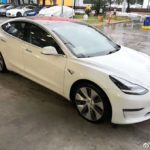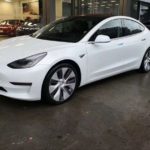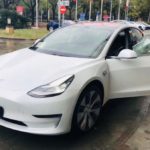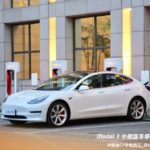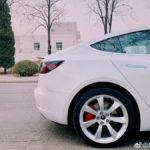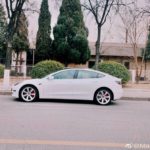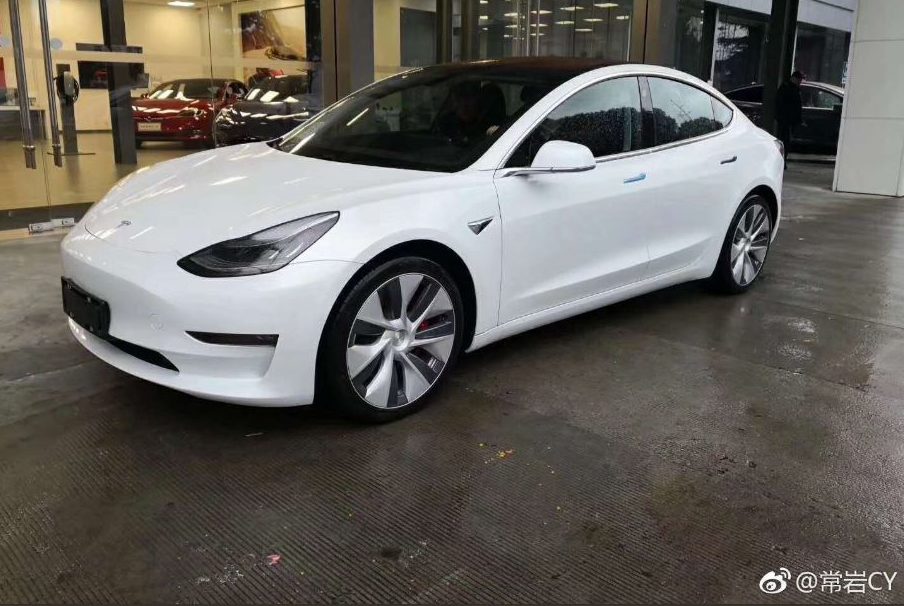
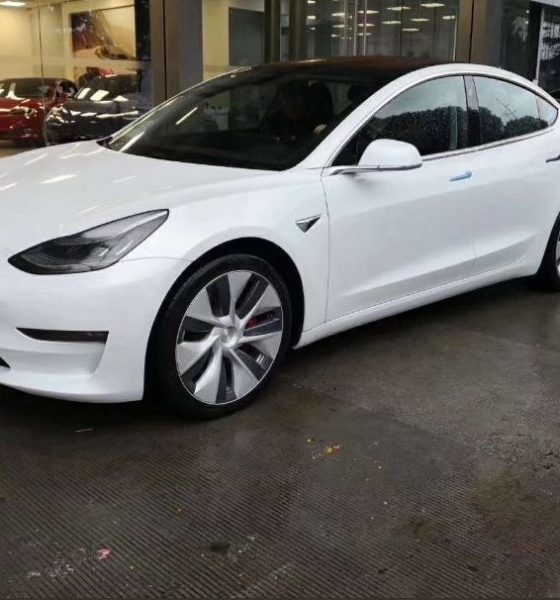
News
Tesla Model 3 Power Sports wheel with aero cover makes grand debut in China as test drives begin
Test drives of the Tesla Performance Model 3 opened yesterday in Shanghai and, as to be expected, pictures of the Chinese variation of the electric car have surfaced online. In photos shared by Twitter user JayinShangahai, in-person glimpses have been captured of the vehicle, including the new 19-inch “Power Sports” wheels, both with and without their aero covers. The Model 3 wheel variation was first spotted in Tesla’s online vehicle configurator for the Chinese market but isn’t yet available in the US.
The Power Sports wheels are said to increase range efficiency and, when used with their aerodynamic hubcaps, “better adapt to different road conditions”, per their description on Tesla’s Chinese Model 3 Design Studio. A similar performance wheel variation is offered in the US market, however the size and appearance are slightly different. The Aero Wheels offered for the North American Model 3 are 18″ as opposed to the 19″ size of the Power Sports version, and the overall design has been reworked from a 5-hole, black/grey style to a 7-hole, silver/grey style. It should also be noted that the Power Sports wheel is only offered on the Model 3 Performance – the Long Range AWD variation will come with either the Aero Wheels or Sports Wheels styles found in North American versions.
- Model 3 Performance Power Sports Wheels on display in China. | Credit: Twitter/@ShanghaiJayin
- Model 3 Performance Power Sports Wheels on display in China. | Credit: Twitter/@ShanghaiJayin
- Model 3 Performance Power Sports Wheels on display in China. | Credit: Twitter/@ShanghaiJayin
- Model 3 Performance Power Sports Wheels on display in China. | Credit: Twitter/@ShanghaiJayin
- Model 3 Performance Power Sports Wheels on display in China. | Credit: Twitter/@ShanghaiJayin
- Model 3 Performance Power Sports Wheels on display in China. | Credit: Twitter/@ShanghaiJayin
- Model 3 Performance Power Sports Wheels on display in China. | Credit: Twitter/@ShanghaiJayin
- Model 3 Performance Power Sports Wheels on display in China. | Credit: Twitter/@ShanghaiJayin
The first batch of Tesla’s Performance Model 3 China edition vehicles arrived about a week ago in Hong Kong. Per the online configurator, delivery of the Dual Motor Model 3 variation is supposed to begin sometime in March, and an additional Standard Range version is slated for mid-2019, completing the full Tesla lineup available to the company’s Chinese customers. The still-unreleased Model Y crossover SUV was originally thought to be part of the all-electric car maker’s coming production plans in China, but in yesterday’s 2018 Full Year Report, Tesla indicated that Gigafactory 1 in Sparks, Nevada would likely be the initial manufacturing site.
Tesla is likely planning on deliveries into China being short-lived in favor of in-country production at its recently ground broken Gigafactory 3 in Shanghai, primarily as a matter of financial sense. An extra 25% import tariff is placed on cars originating in the US, significantly increasing the price of any American vehicles brought into the country. China recently agreed to suspend the extra tariff; however, the suspension is scheduled to end on April 1, 2019. Tesla adjusted their vehicle pricing accordingly with the hope of using the lower tariff advantage to ramp up sales, a plan which was successful. Even still, though, general import taxes remain in force, meaning the electric vehicle manufacturer would need to further reduce tax barriers to truly expand and compete throughout China. Manufacturing Tesla’s cars in Shanghai would accomplish this.
Tesla Model 3 is available for test drive in China 🇨🇳. Starting from TODAY! Just booked mine for tomorrow! Any tips for my first Model 3 Performance test drive? Bonus photo closer look at the 19” Aero Wheels with cap on #Tesla #TeslaChina #Model3Performance #TestDrive pic.twitter.com/adn6YQBGD3
— Jay in Shanghai 电动 Jay 🇨🇳 (@JayinShanghai) January 31, 2019
The Tesla Model 3 Performance is expected to become a strong contender in China’s high-performance sedan market. With a 0-60 mph acceleration time of 3.5 seconds offered at a rival-undercutting price of 560,000 RMB (around $81,000), the value of the vehicle overall speaks for itself. Once Gigafactory 3 is up and running – initial construction is expected to be completed this summer – it is anticipated to reach high volume production shortly thereafter and enter the Chinese market as a true local competitor for other manufacturers doing business in the country.

News
Tesla FSD fleet is nearing 7 billion total miles, including 2.5 billion city miles
As can be seen on Tesla’s official FSD webpage, vehicles equipped with the system have now navigated over 6.99 billion miles.

Tesla’s Full Self-Driving (Supervised) fleet is closing in on almost 7 billion total miles driven, as per data posted by the company on its official FSD webpage.
These figures hint at the massive scale of data fueling Tesla’s rapid FSD improvements, which have been quite notable as of late.
FSD mileage milestones
As can be seen on Tesla’s official FSD webpage, vehicles equipped with the system have now navigated over 6.99 billion miles. Tesla owner and avid FSD tester Whole Mars Catalog also shared a screenshot indicating that from the nearly 7 billion miles traveled by the FSD fleet, more than 2.5 billion miles were driven inside cities.
City miles are particularly valuable for complex urban scenarios like unprotected turns, pedestrian interactions, and traffic lights. This is also the difference-maker for FSD, as only complex solutions, such as Waymo’s self-driving taxis, operate similarly on inner-city streets. And even then, incidents such as the San Francisco blackouts have proven challenging for sensor-rich vehicles like Waymos.
Tesla’s data edge
Tesla has a number of advantages in the autonomous vehicle sector, one of which is the size of its fleet and the number of vehicles training FSD on real-world roads. Tesla’s nearly 7 billion FSD miles then allow the company to roll out updates that make its vehicles behave like they are being driven by experienced drivers, even if they are operating on their own.
So notable are Tesla’s improvements to FSD that NVIDIA Director of Robotics Jim Fan, after experiencing FSD v14, noted that the system is the first AI that passes what he described as a “Physical Turing Test.”
“Despite knowing exactly how robot learning works, I still find it magical watching the steering wheel turn by itself. First it feels surreal, next it becomes routine. Then, like the smartphone, taking it away actively hurts. This is how humanity gets rewired and glued to god-like technologies,” Fan wrote in a post on X.
News
Tesla starts showing how FSD will change lives in Europe
Local officials tested the system on narrow country roads and were impressed by FSD’s smooth, human-like driving, with some calling the service a game-changer for everyday life in areas that are far from urban centers.

Tesla has launched Europe’s first public shuttle service using Full Self-Driving (Supervised) in the rural Eifelkreis Bitburg-Prüm region of Germany, demonstrating how the technology can restore independence and mobility for people who struggle with limited transport options.
Local officials tested the system on narrow country roads and were impressed by FSD’s smooth, human-like driving, with some calling the service a game-changer for everyday life in areas that are far from urban centers.
Officials see real impact on rural residents
Arzfeld Mayor Johannes Kuhl and District Administrator Andreas Kruppert personally tested the Tesla shuttle service. This allowed them to see just how well FSD navigated winding lanes and rural roads confidently. Kruppert said, “Autonomous driving sounds like science fiction to many, but we simply see here that it works totally well in rural regions too.” Kuhl, for his part, also noted that FSD “feels like a very experienced driver.”
The pilot complements the area’s “Citizen Bus” program, which provides on-demand rides for elderly residents who can no longer drive themselves. Tesla Europe shared a video of a demonstration of the service, highlighting how FSD gives people their freedom back, even in places where public transport is not as prevalent.
What the Ministry for Economic Affairs and Transport says
Rhineland-Palatinate’s Minister Daniela Schmitt supported the project, praising the collaboration that made this “first of its kind in Europe” possible. As per the ministry, the rural rollout for the service shows FSD’s potential beyond major cities, and it delivers tangible benefits like grocery runs, doctor visits, and social connections for isolated residents.
“Reliable and flexible mobility is especially vital in rural areas. With the launch of a shuttle service using self-driving vehicles (FSD supervised) by Tesla in the Eifelkreis Bitburg-Prüm, an innovative pilot project is now getting underway that complements local community bus services. It is the first project of its kind in Europe.
“The result is a real gain for rural mobility: greater accessibility, more flexibility and tangible benefits for everyday life. A strong signal for innovation, cooperation and future-oriented mobility beyond urban centers,” the ministry wrote in a LinkedIn post.
News
Tesla China quietly posts Robotaxi-related job listing
Tesla China is currently seeking a Low Voltage Electrical Engineer to work on circuit board design for the company’s autonomous vehicles.

Tesla has posted a new job listing in Shanghai explicitly tied to its Robotaxi program, fueling speculation that the company is preparing to launch its dedicated autonomous ride-hailing service in China.
As noted in the listing, Tesla China is currently seeking a Low Voltage Electrical Engineer to work on circuit board design for the company’s autonomous vehicles.
Robotaxi-specific role
The listing, which was shared on social media platform X by industry watcher @tslaming, suggested that Tesla China is looking to fill the role urgently. The job listing itself specifically mentions that the person hired for the role will be working on the Low Voltage Hardware team, which would design the circuit boards that would serve as the nervous system of the Robotaxi.
Key tasks for the role, as indicated in the job listing, include collaboration with PCB layout, firmware, mechanical, program management, and validation teams, among other responsibilities. The role is based in Shanghai.
China Robotaxi launch
China represents a massive potential market for robotaxis, with its dense urban centers and supportive policies in select cities. Tesla has limited permission to roll out FSD in the country, though despite this, its vehicles have been hailed as among the best in the market when it comes to autonomous features. So far, at least, it appears that China supports Tesla’s FSD and Robotaxi rollout.
This was hinted at in November, when Tesla brought the Cybercab to the 8th China International Import Expo (CIIE) in Shanghai, marking the first time that the autonomous two-seater was brought to the Asia-Pacific region. The vehicle, despite not having a release date in China, received a significant amount of interest among the event’s attendees.
